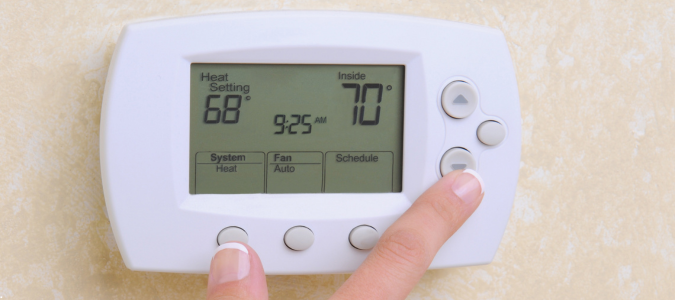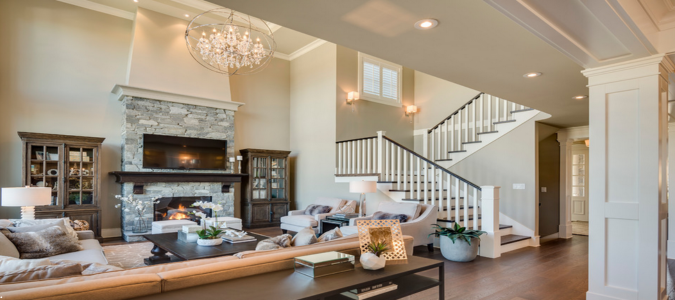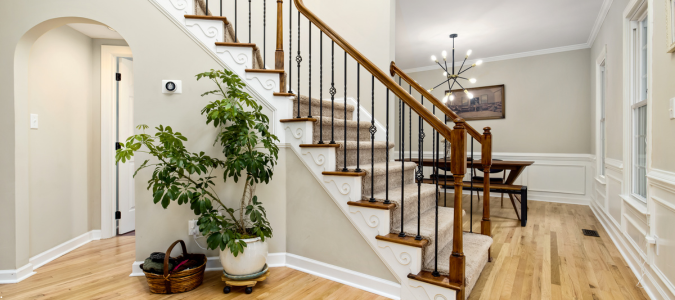As a homeowner, selecting the right temperature for your heater can be a challenging task. On one hand, you want everyone under your roof to be comfortable. And on the other hand, you don’t want a thermostat setting that makes your utility bills skyrocket. So, what temperature do you go for?
What Is the Ideal Thermostat Setting During the Day in Winter?
To keep costs low, the U.S. Department of Energy recommends a temperature range of 68 to 70 degrees in the winter.
However, these figures are not set in stone. Gary Cremeans, HVAC Operations Manager at ABC Home & Commercial Services, says that the best temperature to set your thermostat to in winter is a temperature that is comfortable for you and your family. Additionally, some thermostats may read cooler or warmer depending on a variety of factors.
That said, if you are looking to cut down on your utility bills, there are some factors you can consider when setting your thermostat. Let’s look at certain factors that can guide your decision.
When There Is Someone at Home
When people are at home during the day, you can save energy by setting your thermostat to 68 degrees. This is both comfortable and energy-efficient. During the winter months, heat escapes your home through windows and doors as temperatures drop.
By setting your thermostat to a cozy temperature, you’ll be able to stay warm while saving money on monthly utility bills.
When the House Is Empty
If you will be away from home for an extended period, lower the temperature on your thermostat to 65 degrees. Program your thermostat to raise the temperature a few minutes before you return home. This way, you’ll still get a warm welcome without wasting heat.
Factors That May Affect Your Thermostat Temperature Setting
Whether there’s anyone at home or not, the best temperature for a heater in winter depends on these additional factors:
- Insulation quality
- Energy efficiency goals
- HVAC system age
- Outdoor temperatures
- Home size
Let’s dive into each of these.
Insulation Quality
A well-insulated home is great at retaining heat. So, if your house has good insulation, you can lower your thermostat a few degrees without feeling any less comfortable.
Energy Efficiency Goals
If reducing your energy use is a priority, aim to keep your thermostat at 68 degrees while you’re home and lower it when you’re away. Every degree lower can help cut heating costs.
HVAC System Age
Some heating systems become less efficient as they age. This means older systems may not be able to maintain the temperature you set. You might need to adjust the temperature higher or lower to keep your home warm in winter.
Outdoor Temperatures
When it gets very cold outside, your house loses heat more quickly than usual. Setting your thermostat to around 68 degrees while you’re home helps maintain a comfortable indoor temperature without overworking your heating system.
Home Size
Larger homes often need higher thermostat settings to ensure an even distribution of warm air. This means you may need to set the temperature a few degrees higher so every room stays cozy during colder months.
What Should the Thermostat Be Set at in Winter at Night?
Your body temperature naturally drops at night to help you fall and stay asleep. But if your home is too warm or too cold, it can disrupt that process and throw off your sleep cycle. Being too warm can lead to night sweats, and being too cold may keep you awake.
To strike a balance between comfort and energy savings, experts recommend lowering your thermostat by four degrees for eight hours a day.
Is It Better to Keep the Heat at a Constant Temperature in Winter?
Keeping your thermostat at a constant temperature all winter might seem convenient, but it’s not the most energy-efficient choice. In fact, it can lead to higher utility bills. A smarter approach is to adjust your thermostat based on your daily routine.
Follow these best practices when choosing the best temperature for your heater in winter:
- Increase the heat when people are home.
- Lower the temperature when the house is empty.
- When everyone is tucked into bed, lower the temperature to improve sleep quality.
This routine ensures that your HVAC system operates only as much as necessary. It reduces energy use and helps you stay warm.
How to Keep Your House Warm in Winter
Turning on your heater shouldn’t be your only line of defense against the cold. Let’s look at some additional things you can do to stay warm this winter, which include:
- Seal windows and doors
- Add rugs
- Maintain the furnace
- Improve insulation
- Use thick curtains
- Upgrade windows
Let’s look into each of these tips for keeping your house warm.
Seal Windows and Doors
If your home doesn’t retain heat even when your furnace is on, there might be gaps around your doors and windows. Even small gaps can allow cold air to creep into your home. When this happens, your heater works harder to maintain your set temperature, which can wear it out faster.
To keep your home warm and protect your heater from damage, inspect your windows and doors for gaps that allow air to slip through. If you find any, call in professional help. An HVAC technician will seal these gaps.
Add Rugs
Rugs provide more than just an aesthetic appeal. They also add warmth to your home. With bare floors, such as tiles and hardwood, it’s easier for heat to escape your home. These materials don’t retain heat well, allowing cold air to settle on the surface.
With rugs, you can create an additional layer of insulation between your feet and the cold floor. This reduces heat loss through the floor, helping you maintain a steady indoor temperature.
Maintain the Furnace
Another great way to keep your home warm during colder months is by maintaining your furnace. A well-maintained HVAC unit runs more efficiently, improves indoor air quality and uses less energy. As a result, it distributes heat more evenly throughout your home.
Here are simple maintenance tasks you can do yourself:
- Change the air filter every three months to remove dust and debris.
- Check your home’s air vents to ensure they are not blocked by furniture or rugs.
- Replace old thermostat batteries with new ones.
If your furnace smells like burning or you’re dealing with anything beyond basic maintenance tasks, call in an HVAC specialist. You should also schedule annual checkups to ensure your furnace operates efficiently.
Improve Insulation
Insulation reduces heat loss by creating a protective barrier between your living space and outdoor temperatures. Without proper insulation, heat escapes through your walls, roof and floor. Then, your furnace has to work harder to maintain your preferred temperature.
If you have a heating problem, contact an HVAC technician for insulation upgrades. They can help you compare these two insulation materials: spray foam insulation versus fiberglass.
Use Thick Curtains
Thick curtains provide an additional layer of insulation for your home. Windows are a significant source of heat loss, especially if they’re older. When you opt for high-quality curtains, your home will retain heat better.
For sunny winter days, leave your curtains open to let in natural light. As soon as the sun sets, shut your curtains to trap the heat inside. This approach stabilizes indoor temperatures and reduces energy consumption, saving you money on your heating bill.
Upgrade Windows
Your windows play a big role in how well your home retains heat. Old, drafty or single-panel windows allow a significant amount of warm air to pass through them. This can put a strain on your furnace, making it less efficient, which can lead to higher utility costs.
Upgrading to energy-efficient windows can help reduce heat loss. In the long run, high-performance windows mean year-round comfort in any climate.
Stay Cozy at Home While Cutting Costs
The best temperature for a heater in winter is one that strikes a healthy balance between comfort and cost-efficiency. To keep your heater at optimal performance, schedule annual maintenance with a licensed HVAC professional.
An HVAC specialist will perform maintenance tasks, such as replacing dirty air filters, adjusting the flame sensor, inspecting the heat exchanger for cracks and ensuring the system operates efficiently. If your furnace becomes less efficient, smells like burning or consumes more energy than usual, reach out to the pros.
ABC Can Keep You Comfortable In Your Home
Relaxing at home becomes a challenge if you are constantly either too hot or too cold. If you have problems keeping your home temperature comfortable, bring in a professional to advise you on your options. The experienced technicians at ABC Home & Commercial Services can make any needed repairs, perform maintenance and even help you choose and install a new unit, if it makes more sense to replace your unit.



